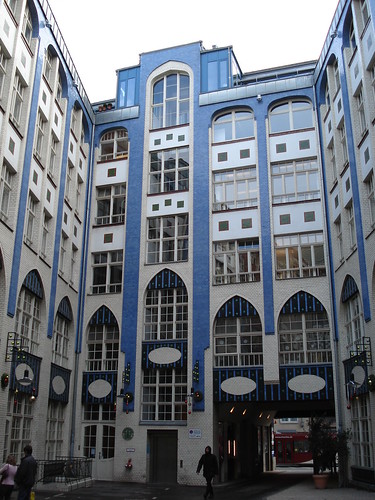
The Hackesche Hof comprises of a series of Jugendstil (art nouveau) style courtyards in what was once one of Berlin's main Jewish districts. Badly damaged in the Second World War, this beautifully restored building is now a thriving tourist destination and is also popular with Berliners who go to visit the cafes, shops, art galleries, the Hackesche Hof Theatre and the Chameleon Cabaret.
Architect August Endell designed the courtyards and construction commenced in 1905. Endell was one of the forerunners of the Jugendstil in Germany and was a contemporary of, and admired by leading artists including Lovis Corinth and Ernst Ludwig Kirchner. Like many artists of his time, Endell was multi-talented and also worked as a teacher and writer, being co-editor of the literary magazine Pan from 1895-1900.
The original Hof housed a number of interesting organisations - an expressionist poets' association in 1909, a Jewish students' canteen in 1913, a Jewish Girls' Club founded in 1916, the Imperial Cinema in 1921as well as wine sellers and a department store. The legal owner of the Hof before the second world war, Jacob Michael, was forced into exile in 1933 and his heirs had to wait until 1993 to have the asset returned to them. Formerly part of the Russian Zone of occupation at the end of the war, the Soviet administration requisitioned the property in 1945. In 1951 the building became communally resident owned and the tenants' association opposed the proposed destruction of the original Jugendstil facade, but it was not until 1995 that restoration began in earnest.
The area is rich in history. The partially restored New Synagogue on Oranienburger Strasse is a testament to the once thriving Jewish presence here. Today it serves partly as a museum but also hosts services. The Synagogue's beautiful domes once again rise above this part of Berlin after the building was extensively damaged on the night of 9th November 1938 - Kristallnacht - when synagogues, Jewish businesses and homes were destroyed across Germany, Austria and the occupied Czech lands as the precursor to the Holocaust. One Otto Bellgardt a local policeman prevented complete destruction by holding the mob at bay with a pistol, saying that he was protecting an historical monument. The site of the former Gross Hamburger Strasse Jewish cemetery is very near. The cemetery was destroyed by the Gestapo in 1943 and one symbolic gravestone remains for philosopher Moses Mendelssohn. Also close by is the small museum commemorating Otto Weidt, who employed and protected a number of blind and deaf Jews in his brush factory, bribing officials to overlook their presence and going so far as to travel to Auschwitz to secure the release of Alice Licht one of his workers after she was arrested and deported. His story is little known, but he was a real hero, who sadly died very soon after the war ended.
There are several coffee houses in the Hof and a number of good shops. I bought three very beautiful Jugendstil ceramic tiles from a shop called Golem(!) which now grace my kitchen wall and also enjoyed browsing some of the vintage furniture and household goods stores in the small arcade at the side of the complex. The Hackesche Markt (market) lies opposite the Hof and has several stalls selling (in my opinion) the revolting and recently invented "curry wurst" which my travel companion sampled. It consisted of a sausage coated in tomato ketchup and then thickly sprinkled with curry powder. I'll stick with the cakes.
No comments:
Post a Comment